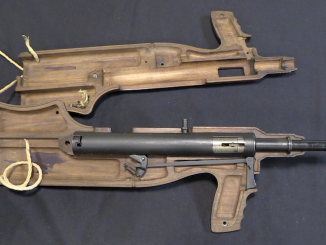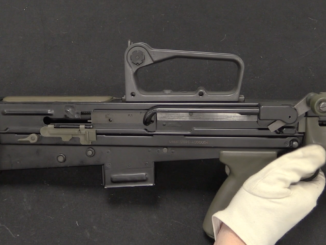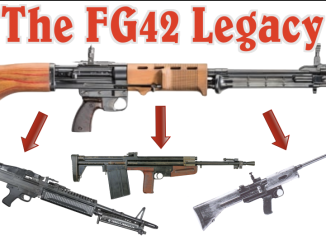RIA’s catalog page for this rifle
The main British sniper rifle of World War Two, and arguably one of the best looking military sniper rifles of all time, the No4 MkI (T) was something the British military knew they would want even before the No4 MkI rifle had gone into real production. The first No4 snipers were built on leftover trials rifles from Enfield, and the pattern was formally introduced in February of 1942. First use was in North Africa, but the fighting there was not really suited to sniper rifles, and the weapon’s practical combat debut was in Italy in 1943.
The No4 MkI (T) was a conversion of a standard No4 MkI rifle, using examples chosen for particular good accuracy. They were sent to Holland & Holland to have scope mount bases added and No32 telescopic sights fitted (along with cheek risers on the stocks and having the battle sight aperture ground off to allow room for the scope bell). Between 23,000 and 26,000 were made during the war, and they would continue to be used in the British military for decades, including later conversion into 7.62mm NATO L42A1 rifles.




what is the difference between a No.4 MK1 (t) and a No.4 MK2 (f)? I have one of the latter, that, at sometime in the past was “sporterized”. I bought it as a shooter, (though I have yet to take it out to the range) and have wondered about it. Thanks in advance, and keep up the good work!
The Mark one had the trigger hung from the trigger guard, the Mark two had the trigger hung from the action.
The Mark 2 has a more consistent trigger feel as a result.
There is a also a Mark1/2 which is a Mark one which has been updated.
The Mark 1☆ was the budget wartime model with two groove rifling and a pressed steel rear sight.
There other differences between the marks but the above are the main ones.
Allan Harville I think the (f) might stand for Royal Ordnance Fazakerley. Most of the post war No4 Mk2 rifles were built at Fazakerley. The Mk2s are brilliant rifles that didnt have the wartime work arounds to speed up production just a pity some idiot ruined it.
Have a sniper and it has a problem. Bolt will not cycle after firing. Have trouble even opening it up and am not inclined to shoot it with it being this way. No idea why it is not working.
Any ideas?
Check the headspace. You may have excessive headspace and that is causing the bolt to seize. One issue with military surplus rifles is the bolt gets swapped–and that’s just begging for headspacing problems.
It’s difficult to guess without looking closely at it.
“Headspace” is one of the semi propaganda slanders that emerged when American dealers bought up parts that had been scrapped because they were worn out, and sold them…
And being “entrepreneurial” souls, some of the scrappers got dressed up to look like more appealing guns than they ever were before they wore out.
Actual headspace tolerance is up to 0.01″ which sounds hideous if you are used to rimless cases that headspace on thin and gently tapered brass at the case shoulder and use headspace of 0.003″ to 0.006″.
But in practice, it works well with the much more positive location provided by the rim, and the case may actually be displaced for a shorter distance by the firing pin impact than a lot of rimless cases are…
There’s nothing to be gained by trying to achieve tighter headspacing than the military specs.
Laidlaw’s website covers the checks for fitting new bolts and for achiving correct headspace
He also points out that the locking seats in the receiver (which are cut on a helix) were induction hardened.
Wartime production pressure sometimes lead to the depth of the heat treatment being shallow and in some rifles this would wear through after considerable use in dirty conditions
Resulting in the seats peening and wearing faster.
You’ll probably get a much better idea of what might be going on, from reading Laidlaw
Thanks Keith, I appreciate the info. Do you have a link to Laidlaw’s site?
[off-topic so ignore if you wish]
Some time ago presence of two interesting weapons become more widely known, see photos:
https://mpopenker.livejournal.com/2356347.html
there are early Mannlicher automatic rifles, which use short-recoil principle, dates back yet to 1880s and use 11 mm (Werndl) cartridge, then default Austrian-Hungarian rifle cartridge.
Anyway, this design proved to be too ahead of its time, at least in terms of doctrine, as automatic rifles, would appear in battle during Great War.
“It’s not heavy–it’s my rifle!”
Compare the No. 4 Mk I(T) to the US M1C and M1D rifles and tell me that the Enfield was ‘overweight’ again. Compared to the M40 system the Enfield is pounds lighter–the M40 weighed in at 14 plus pounds.
How does the Type 97 Sniper Rifle compare to all of the above?
The L42a1 got an even heavier barrel.
Initial trials (L42) with a 7.62×51 conversion, using the external dimensions of the no4 barrel, gave disappointing accuracy results.
Civilian target shooters showed the way forward, with a heavier profile, free floating barrel.
And yours for only $79! Complete with “Fitted Rifle Chest”. Sadly you’ll need a time machine to take you back to 1967 to order one from Interarms/Hunters Lodge.
https://gunsmagazine.com/guns-magazine-1967-classic-editions/
Why they called them “Royal Enfields” I’ve no idea…That’s a Motorcycle!
What are the cutouts for on the cheek pad? Is it so you can shoot it comfortably left handed or right handed?